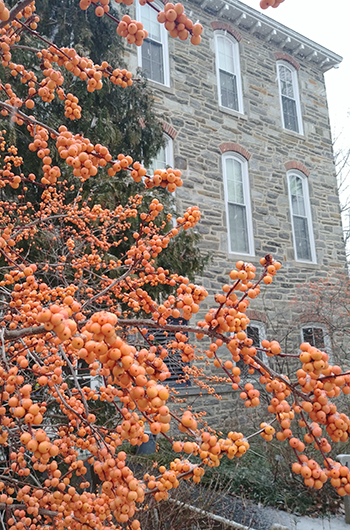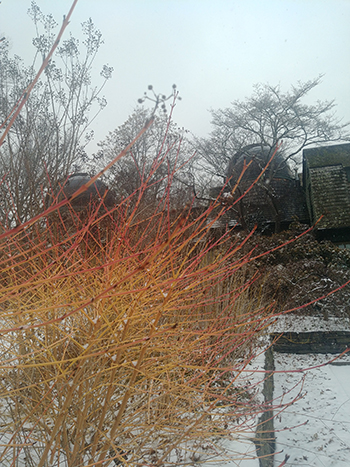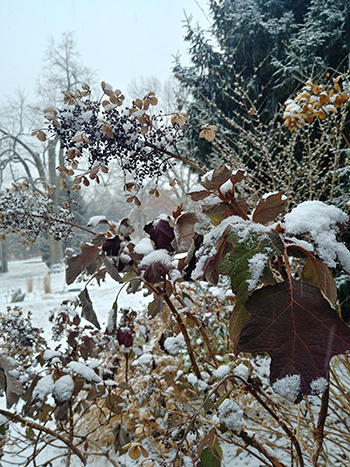
Plants of the Week: Feb. 28

In the winter garden, the focus often shifts to trees. With deciduous trees revealing their wonderful forms and evergreens providing color and structure, it’s easy to be wooed – and to overlook the aesthetic role of shrubs. Shrubs can help to pull the garden together in winter, providing interesting bark, berries, and flowers, without taking up as much room as trees.
A pop of orange can be found on Ilex verticillata ‘Winter Gold’ (winterberry). This marvelous cultivar is a sport of the ‘Winter Red’ cultivar. As much as I love the classic red winterberry, the peachy orange berries (they aren’t very gold) of ‘Winter Gold’ really speak to me. Each time I pass the entrance to John W. Nason Garden by Trotter Hall, my eye is drawn to the two I. verticillata ‘Winter Gold’ plants flanking the south entry, their bountiful berries a bright and welcoming sight. Photo credit: R. Payne-Meyer

Another shrub keeping things peachy around in the Terry Shane Teaching Garden is Cornus sanguinea ‘Cato’ (Arctic Sun™ bloodtwig dogwood). This colorful cultivar of the blood-twig dogwood also strays from the typical red coloration to shades of peach, pink and yellow. Intermittent pruning helps to rejuvenate this shrub, providing greater vigor and brighter colored stems (the newest stems provide the brightest color). To rejuvenate, remove a quarter to a third of the oldest stems each year. You can also prune to the branch intersections, thickening certain junctions, or if the shrub has become large and unwieldy, leave just a few inches of stems at the base for a real restart. Photo credit: R. Payne-Meyer

And lastly, Hydrangea quercifolia (oakleaf hydrangea) continues to shine, though far removed from its flowering period. Another native to the Southern US, this shrub has a remarkable ability to retain its old foliage and flowers through the winter. In the spring, the upright panicles are a lovely sight, and in the fall, foliage takes on shades of deep red, burgundy and purple. The unique oak-leaf shape of the leaves sets this species apart from many other hydrangeas, which often have mundane foliage. Add flaking orange bark, and you can see why H. quercifolia is a stand-out shrub for winter interest. There are many H. quercifolia cultivars available, offering many floral and foliage characteristics in a range of sizes. A great specimen can be found in the Rose Garden Circle. Photo credit: R. Payne-Meyer
Visit the Scott Arboretum today to see these colorful shrubs for yourself! Try using the Arboretum Navigator at scottarboretum.org to locate these plants, as well as the many other botanical treasures found here at the Arboretum.





No Comments